by A. Wayne Ferens
Images Courtesy of Ford Motor Company Archives and the Ferens Collection
Published 1.3.2024
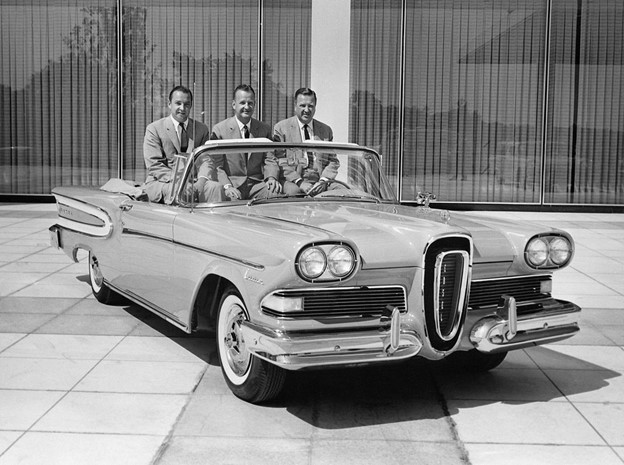 Benson, William Clay and Henry Ford, II seated in the new Edsel Citation convertible on the day the Edsel was introduced on September 4, 1957. (Ford Motor Company Archives)
Benson, William Clay and Henry Ford, II seated in the new Edsel Citation convertible on the day the Edsel was introduced on September 4, 1957. (Ford Motor Company Archives)
On January 17, 1956, Ford Motor Company became a publicly owned business after 53 years of Ford family ownership. Henry Ford became the majority stockholder back in 1908 after purchasing the shares from some of the original investors, and by 1919 Henry owned 100 percent of the company.
In the 1950s, Ford was doing well with the pent-up demand for cars after World War II. They introduced many new models that were selling all the company could build with the introduction of the following: the F-series truck in 1948; the new Ford, Mercury and Lincoln cars in 1949, '52 and '55; the development of the OHV V8 engine in 1954; the Thunderbird in '55; and the formation of the Continental Division with the unveiling of the limited production Continental MKII in 1956.
On September 4, 1957, Ford introduced its newest model called the Edsel. The company called that day E-Day. The Edsel was to have its own division, but there was mixed enthusiasm and emotions from management. President and CEO Henry Ford II, the project’s biggest supporter (except for the name), would have none of it. The car was named in honor of the Deuce’s father, Edsel B. Ford, who passed away in 1943 and was the only son of the company founder Henry Ford.
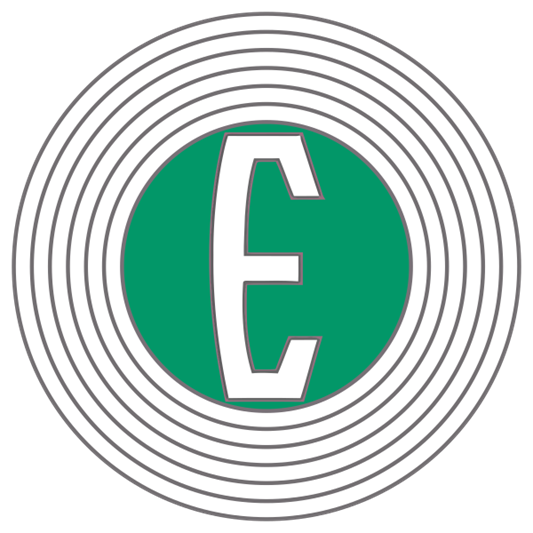 The Edsel Division logo (Ford Motor Company Archives)
The Edsel Division logo (Ford Motor Company Archives)
Development of the Edsel started in 1955. It became known as the E-car, short for "Experimental car." Introduced for the 1958 model year, the Edsel produced four models: the larger Citation and Corsair and the smaller, lower priced Pacer and Ranger. Different body styles were offered depending on the model:
- Citation: two-door hardtop, four-door sedan, two-door convertible;
- Corsair: same but no convertible;
- Pacer: two-door, four-door, two-door sedan, two-door convertible;
- Ranger: two-door, four-door, two-door sedan, four-door sedan.
In addition, the Bermuda, Villager and Roundup were station wagons based on the two smaller Edsel models and were basically the same as the 1957-59 Ford wagons.
The E-car project was an ambitious one from the start with much planning and design. The Edsel would feature high-end features like self-adjusting brakes; automatic transmission with Teletouch Drive -- with push-buttons mounted on the steering wheel hub; air-conditioning; and Ford's newest "FE-series" V-8 engine. Also, the Edsel would be available with 90 possible color combinations and was one of the biggest new model launches in the history of the automobile industry. Ford's investment for the new Edsel was upwards of $300 million.
With more than 1,100 newly appointed dealers around the country, they would be supported by Ford's new Edsel Division all promoting the Edsel as an "entirely new kind of car" and betting on the notion that American consumers would keep spending more and more on flashier expensive cars. A bet that would not pay off ...
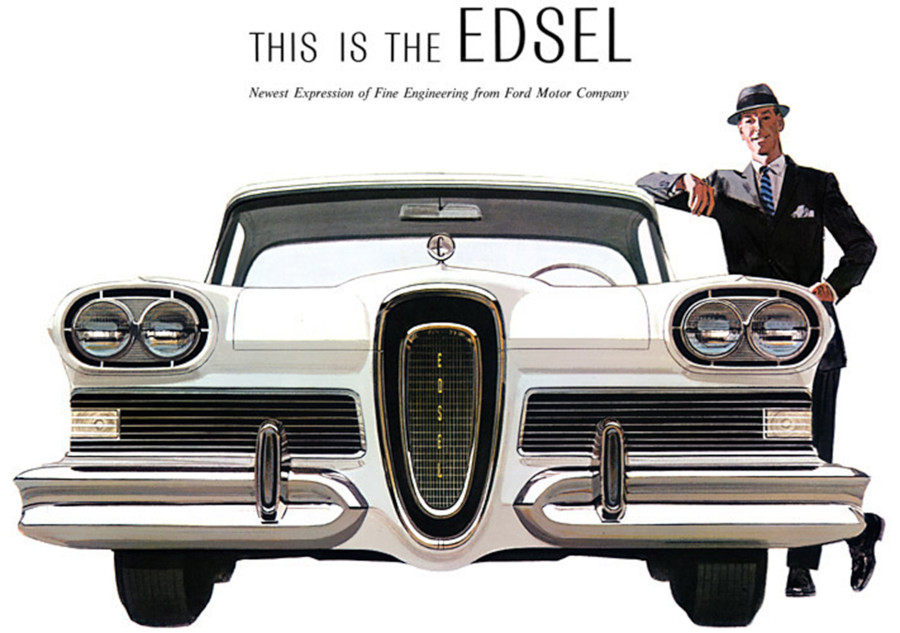 The Edsel’s trademark feature -- the "horsecollar" grill -- was one of many descriptive adjectives given to its unique design. Edsel brochure cover (Ford Motor Company Archives)
The Edsel’s trademark feature -- the "horsecollar" grill -- was one of many descriptive adjectives given to its unique design. Edsel brochure cover (Ford Motor Company Archives)
With a recession looming in the U.S., three issues caused the Edsel to falter almost instantly:
- The unusual look of the new car -- especially its signature oval grill;
- Quality issues noted by Consumer Reports;
- and the cars’ pricing.
The most costly Edsel had a price tag of over $4,000, or about $36,000 today, and overlapped with Ford's own Mercury product line. The confused consumer couldn't figure out whether the Edsel was a mid-market or luxury automobile.
In the first year, 63,110 Edsels were sold in the United States, and only 4,935 in Canada. In 1959, the larger Citation and Pacer models were dropped. The Corsair was offered in a two-door and four-door hardtop, four-door sedan and two-door convertible. The Ranger was sold in a two-door and four-door hardtop, two-door and four-door sedan and the Villager station wagon.
In the 1959 model year, 44,891 Edsels were sold in the United States, with 2,505 sold in Canada. Ford produced only 2,846 for the 1960 model year and announced the end of the Edsel program on November 19, 1959. In total, only 118,287 Edsels were built, including the 7,440 that were produced in Ontario, Canada.
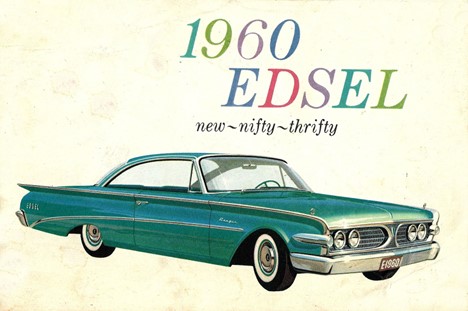 The 1960 Edsel was quite different from the original models introduced on September 4, 1957. Gone is the infamous center grill - the Edsel's most memorable design feature. 1960 Edsel brochure cover (Ford Motor Company Archives)
The 1960 Edsel was quite different from the original models introduced on September 4, 1957. Gone is the infamous center grill - the Edsel's most memorable design feature. 1960 Edsel brochure cover (Ford Motor Company Archives)
For any business, the success or failure of a product, or a new model in this case, can only be measured in dollars and cents. The failure of the Edsel was no exception, and it became Ford's costliest mistake in history. Experts estimate the Edsel cost Ford roughly $350 million ($2.5 billion in today's dollars) in losses, or roughly $3,200 per vehicle sold. The Edsel had such a negative impact on Ford's finances that the company's net income per share dropped from $5.40 in 1957 to just $2.12 in 1958. Ford also cut its dividend from $2.40 to $2 to mitigate the Edsel's impact on its balance sheet. Finally, Ford's share price itself dropped from above $60 to below $40.
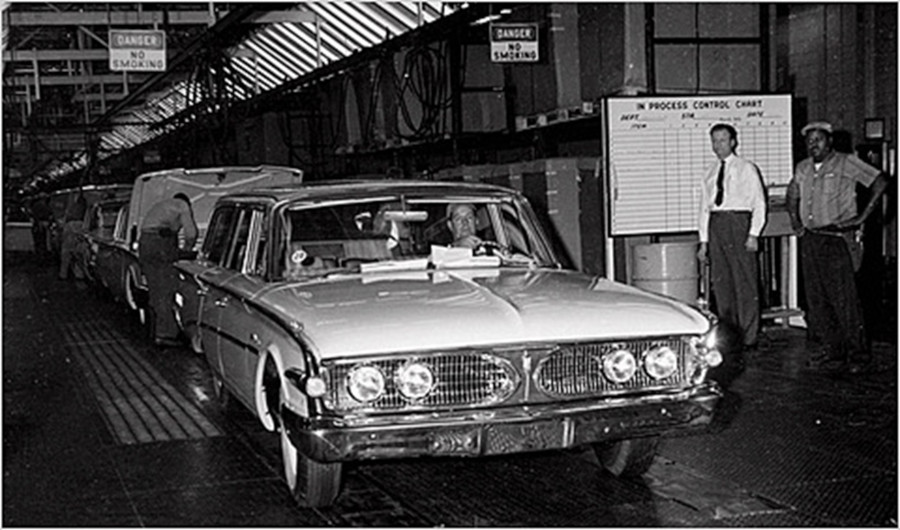 The last Edsel Villager rolling off the line at Ford's Louisville, Kentucky assembly plant on November 19,1959 is totally unrecognizable from the 1958 model. (Ferens Collection) The last Edsel Villager rolls off the line (Ferens Collection)
The last Edsel Villager rolling off the line at Ford's Louisville, Kentucky assembly plant on November 19,1959 is totally unrecognizable from the 1958 model. (Ferens Collection) The last Edsel Villager rolls off the line (Ferens Collection)
Whatever external forces or reasons for the Edsel's failure -- the economic recession, reliability issues, it's unappealing name and/or design, poor marketing or price -- one thing is certain: Ford or any other manufacturer wouldn't dream of releasing a mass product today without monumental market research.
Bibliography:
Motor Trend, October 1957.
Consumer Reports, March 1959.
Lacy, Robert. “Ford - The Men and the Machine.” 1986.
Benzinga Financial News, 2019.



